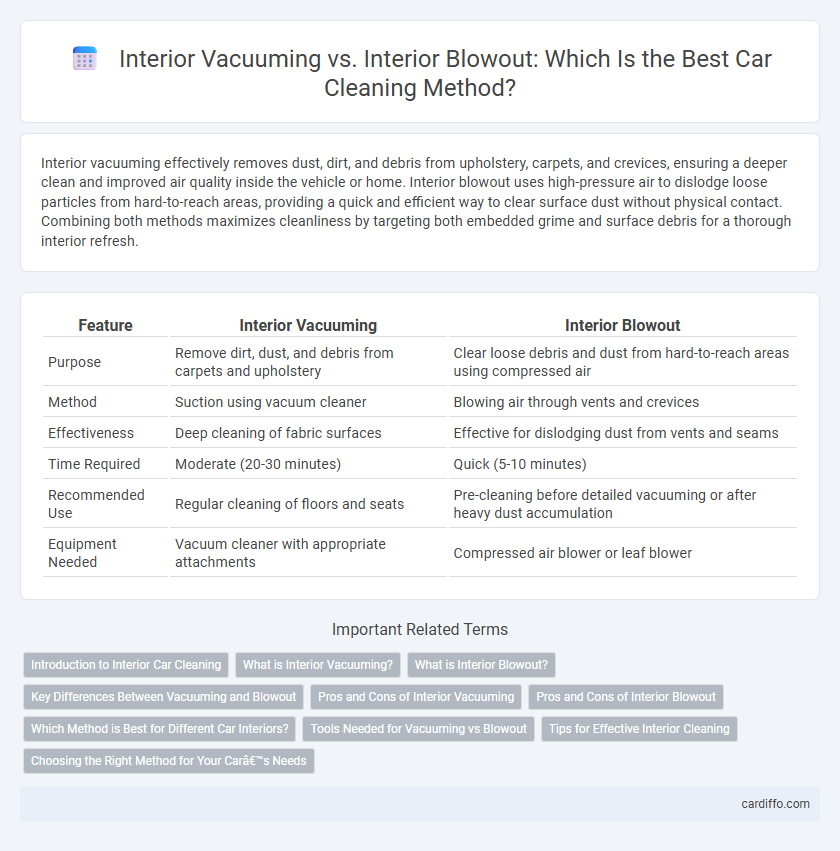Interior vacuuming effectively removes dust, dirt, and debris from upholstery, carpets, and crevices, ensuring a deeper clean and improved air quality inside the vehicle or home. Interior blowout uses high-pressure air to dislodge loose particles from hard-to-reach areas, providing a quick and efficient way to clear surface dust without physical contact. Combining both methods maximizes cleanliness by targeting both embedded grime and surface debris for a thorough interior refresh.
Table of Comparison
| Feature | Interior Vacuuming | Interior Blowout |
|---|---|---|
| Purpose | Remove dirt, dust, and debris from carpets and upholstery | Clear loose debris and dust from hard-to-reach areas using compressed air |
| Method | Suction using vacuum cleaner | Blowing air through vents and crevices |
| Effectiveness | Deep cleaning of fabric surfaces | Effective for dislodging dust from vents and seams |
| Time Required | Moderate (20-30 minutes) | Quick (5-10 minutes) |
| Recommended Use | Regular cleaning of floors and seats | Pre-cleaning before detailed vacuuming or after heavy dust accumulation |
| Equipment Needed | Vacuum cleaner with appropriate attachments | Compressed air blower or leaf blower |
Introduction to Interior Car Cleaning
Interior vacuuming removes dirt, dust, and debris from seats, carpets, and floor mats, enhancing the overall cleanliness and freshness of the vehicle's interior. Interior blowout uses compressed air to dislodge dust and particles from hard-to-reach areas like air vents, dashboard crevices, and under seats, ensuring a thorough cleaning beyond surface vacuuming. Both methods are essential in comprehensive car detailing, improving air quality and maintaining upholstery condition.
What is Interior Vacuuming?
Interior vacuuming involves using a powerful vacuum cleaner to remove dust, dirt, and debris from car interiors, including seats, carpets, floor mats, and crevices. This method effectively captures fine particles, allergens, and pet hair, promoting a cleaner and healthier cabin environment. Vacuum tools such as crevice nozzles and brush attachments enhance the ability to reach tight spaces and upholstery without causing damage.
What is Interior Blowout?
Interior blowout is a powerful cleaning method that uses compressed air to remove dust, dirt, and debris from hard-to-reach areas inside a vehicle or building. Unlike interior vacuuming, which relies on suction to lift particles from surfaces, blowout targets crevices, vents, and fabric fibers with high-pressure air, ensuring deeper cleanliness. This technique is especially effective for eliminating embedded contaminants that vacuuming alone might miss, enhancing overall interior hygiene.
Key Differences Between Vacuuming and Blowout
Interior vacuuming involves using a vacuum cleaner with various attachments to extract dust, dirt, and debris from surfaces like carpets, upholstery, and tight crevices, ensuring a thorough and controlled cleaning process. In contrast, interior blowout relies on compressed air to forcefully dislodge and remove particles from hard-to-reach areas such as vents, dashboards, and car interiors, often faster but less precise than vacuuming. The key differences lie in the method of debris removal--vacuuming sucks contaminants into a storage unit for disposal, while blowout blows debris out, potentially spreading dust if not managed properly.
Pros and Cons of Interior Vacuuming
Interior vacuuming effectively removes dust, dirt, and small debris from car upholstery and carpets, enhancing cleanliness and air quality inside the vehicle. It is a quieter, more controlled method than blowouts, reducing the risk of spreading dirt to unwanted areas; however, vacuuming may struggle to extract dirt from hard-to-reach crevices or deeply embedded particles. The process requires manual effort and time, potentially making it less efficient for heavily soiled interiors compared to the rapid, forceful debris removal achieved by interior blowouts.
Pros and Cons of Interior Blowout
Interior blowout effectively removes dust, dirt, and debris from hard-to-reach areas such as air vents, dashboard crevices, and under seats, making it ideal for a thorough deep clean. However, blowouts can disperse dust particles into the air, potentially causing respiratory issues for sensitive individuals and may leave fine particles resettled on surfaces. Compared to vacuuming, interior blowouts are faster but less precise, often requiring a follow-up vacuum to completely remove dislodged dirt.
Which Method is Best for Different Car Interiors?
Interior vacuuming effectively removes dust, dirt, and debris from fabric seats and carpets, preserving delicate upholstery fibers without causing damage. Interior blowout excels at dislodging stubborn dust and debris from hard-to-reach areas such as air vents, dashboard crevices, and door pockets, ideal for vehicles with extensive plastic or vinyl interiors. Choosing between vacuuming and blowout depends on the car's interior material, with vacuuming preferred for textile surfaces and blowout favored for intricate hard surfaces.
Tools Needed for Vacuuming vs Blowout
Interior vacuuming requires a high-powered vacuum cleaner equipped with specialized attachments such as crevice tools, brush nozzles, and extension hoses to efficiently remove dust, debris, and allergens from carpets, upholstery, and hard-to-reach areas. Interior blowout necessitates the use of compressed air tools or automotive blowers designed to dislodge dirt and dust from vents, dashboard crevices, and under seats without direct suction. The choice of tools impacts cleaning effectiveness, with vacuuming tools capturing and containing debris, while blowout tools focus on loosening particles for subsequent removal.
Tips for Effective Interior Cleaning
For effective interior cleaning, use a vacuum with strong suction to remove dirt and debris from carpets, seats, and crevices, ensuring a thorough clean without spreading dust. An interior blowout complements vacuuming by using compressed air to dislodge particles from hard-to-reach areas like vents, seams, and under seats, enhancing overall cleanliness. Combine vacuuming and blowout techniques regularly to maintain a dust-free, allergen-reduced vehicle interior for optimal hygiene.
Choosing the Right Method for Your Car’s Needs
Interior vacuuming effectively removes dirt, dust, and debris from upholstery and carpet fibers, preserving fabric quality and preventing wear. Interior blowout uses high-pressure air to dislodge loose particles from hard-to-reach areas like vents and crevices, enhancing overall cleanliness without disturbing delicate surfaces. Selecting the right method depends on your car's interior condition, with vacuuming best for deep grime and blowout ideal for thorough dust removal in tight spaces.
Interior Vacuuming vs Interior Blowout Infographic

 cardiffo.com
cardiffo.com